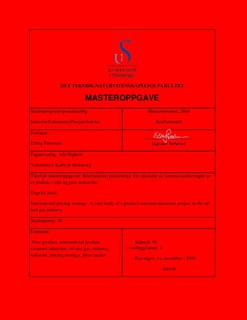International pricing strategy: A case study of a product commercialization project in the oil and gas industry
Master thesis

View/
Date
2016-12Metadata
Show full item recordCollections
- Studentoppgaver (TN-ISØP) [1451]
Abstract
The purpose of this thesis was to investigate if an optimal pricing strategy could be defined for the global release of a new software in the oil and gas industry, and how the degree of competition would affect the choice of that strategy. To do this, the author chose to conduct in-depth interviews and perform an extensive literature review.
The findings from these activities were used as a basis to perform a case study, utilizing two renowned strategic analysis tools; Porter’s Five Forces and a modified version of the VRIO model. The results revealed that in order for the Company to enable itself to utilize a pricing strategy optimally, it needs to invest in a dedicated pricing position which will analyze, implement, monitor and drive pricing strategies. The person holding this position needs to be educated on the subject and have pricing experience, preferably of international character.
The analysis also revealed that the Company did not have extensive knowledge about new product pricing strategy theory and did not invest sufficiently into utilizing best practice. The study uncovered two resources, customer incumbency and a time savings algorithm, that yielded temporary competitive advantage and two competitive forces, rivalry and threat of new entrants, that differentiated the international market from the Gulf of Mexico market.
The conclusion was that a generic global pricing strategy is not optimal, but needs to be specifically tailored to the unique environment in which the product is released and sold. That environment consists of the Company that is developing and commercializing the product, the competitors and the potential customers.
Finally, the degree of competition was found to be the most influencing factor for choosing a price strategy for this product.
Description
Master's thesis in Industrial economics.